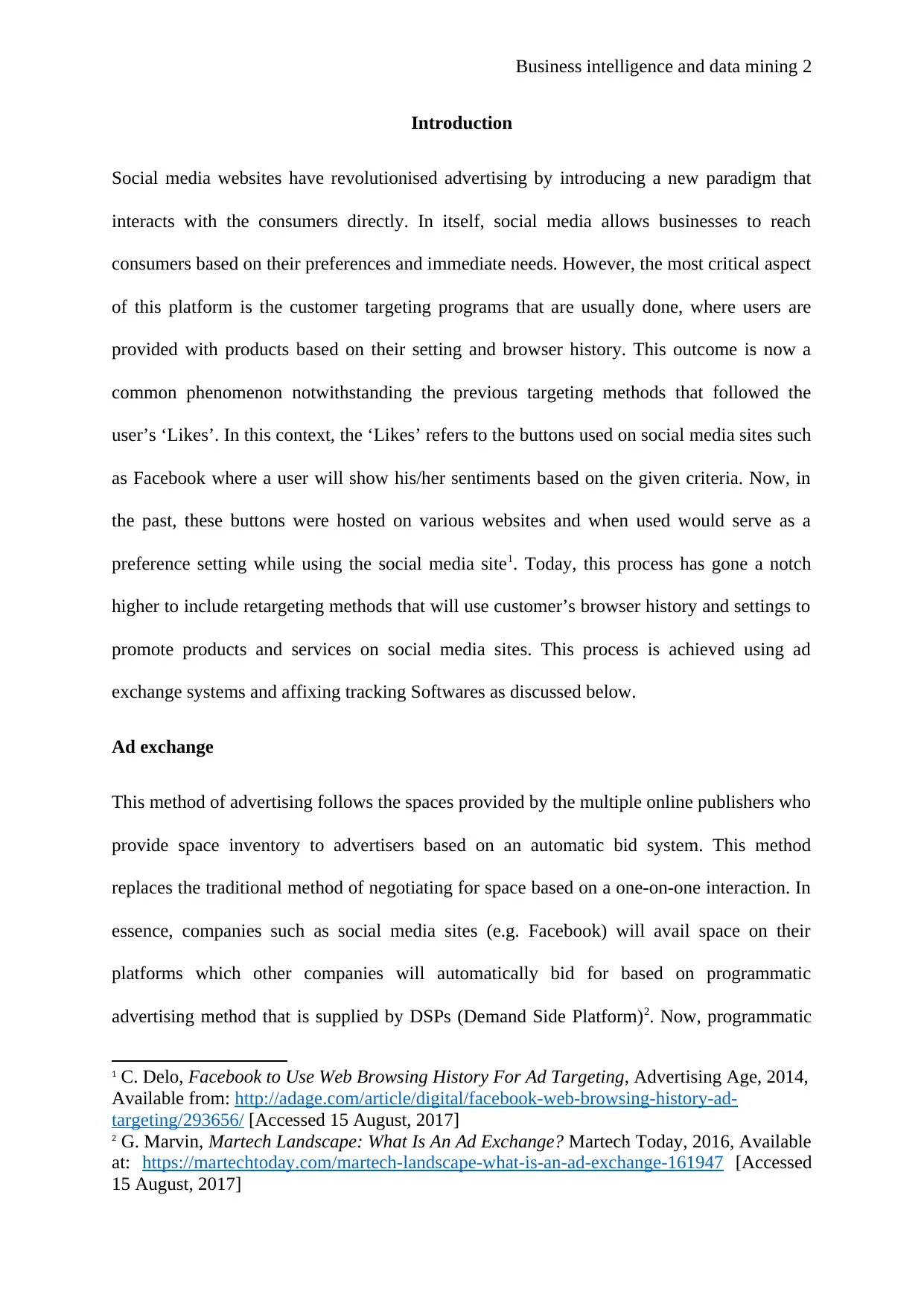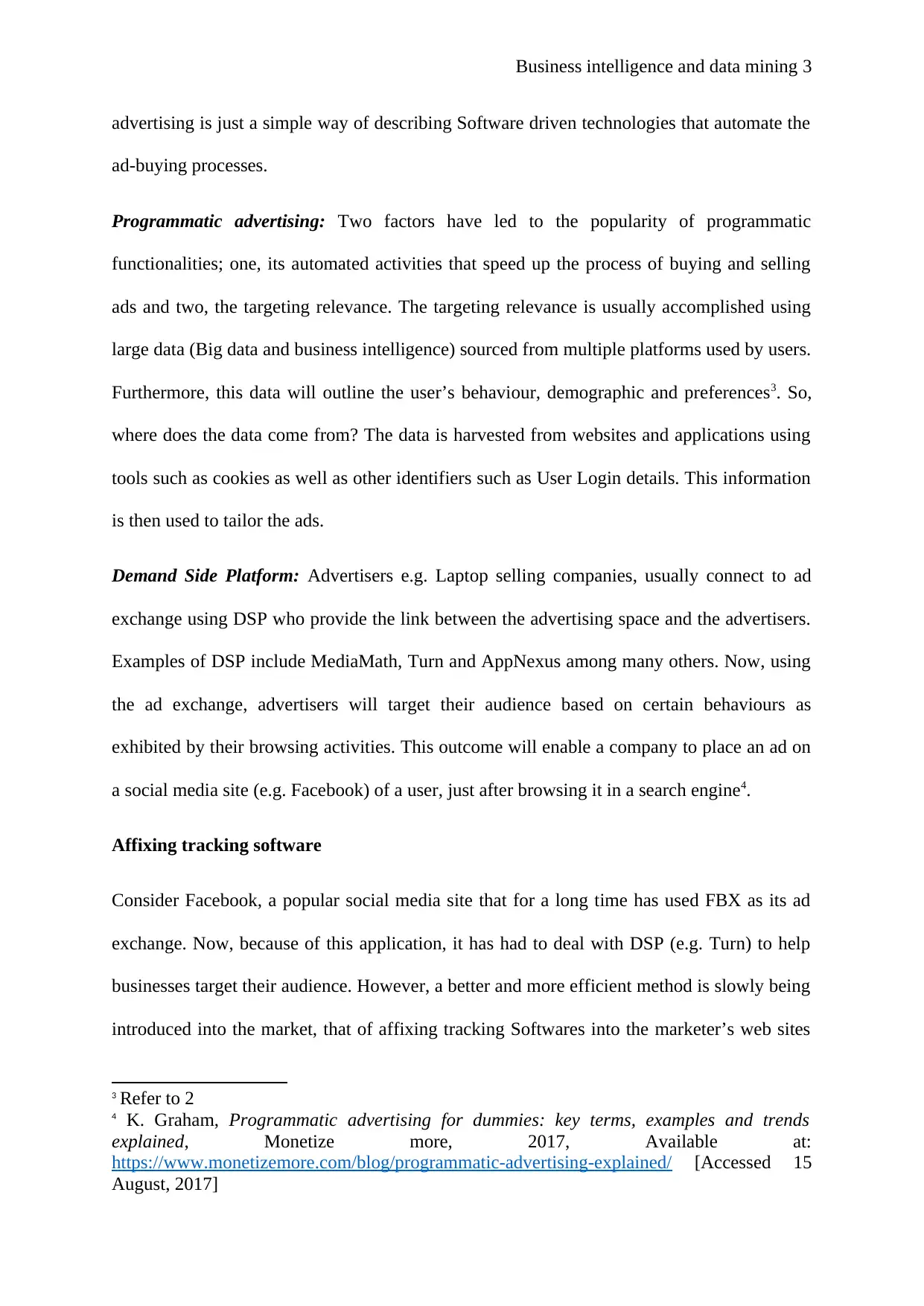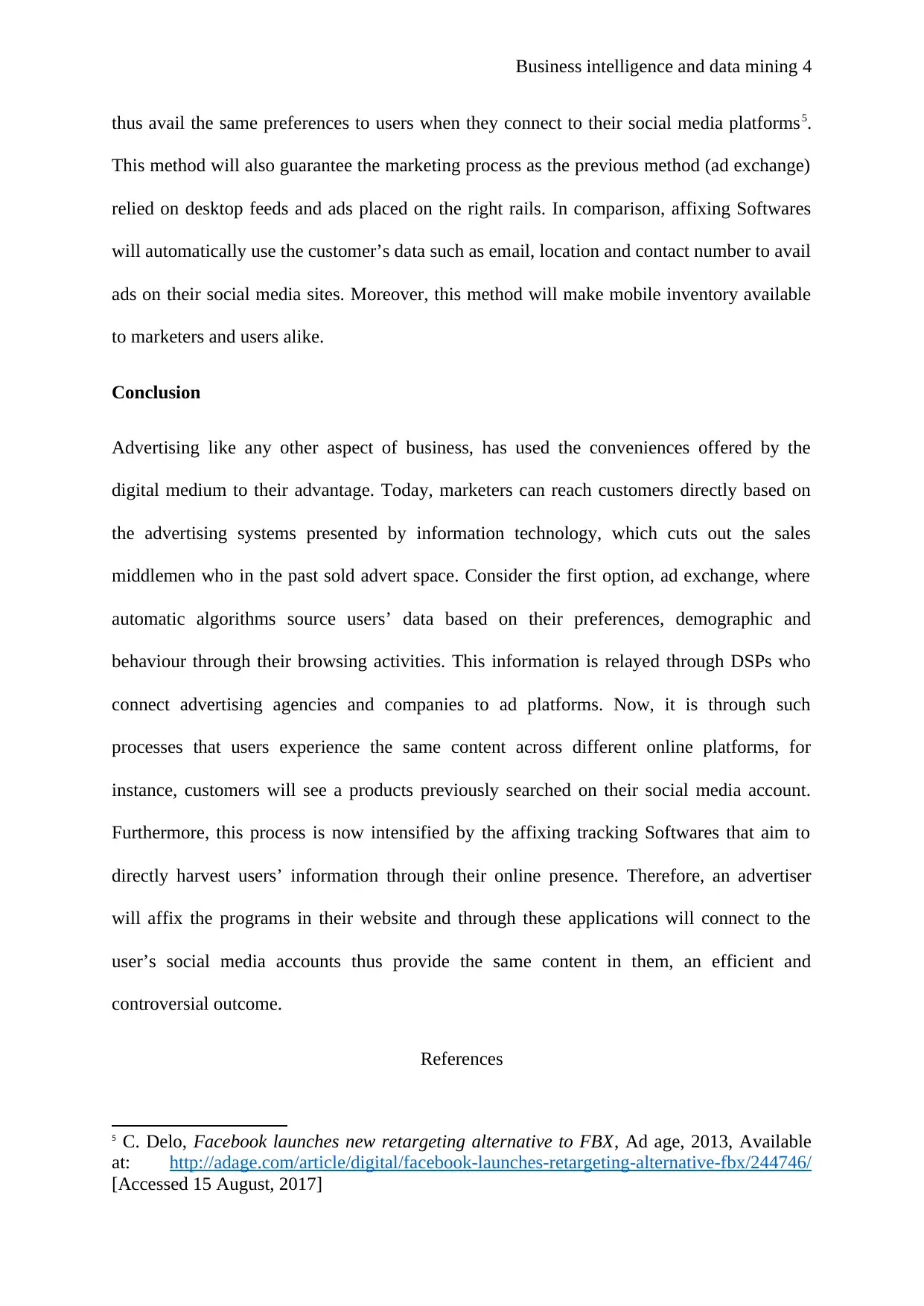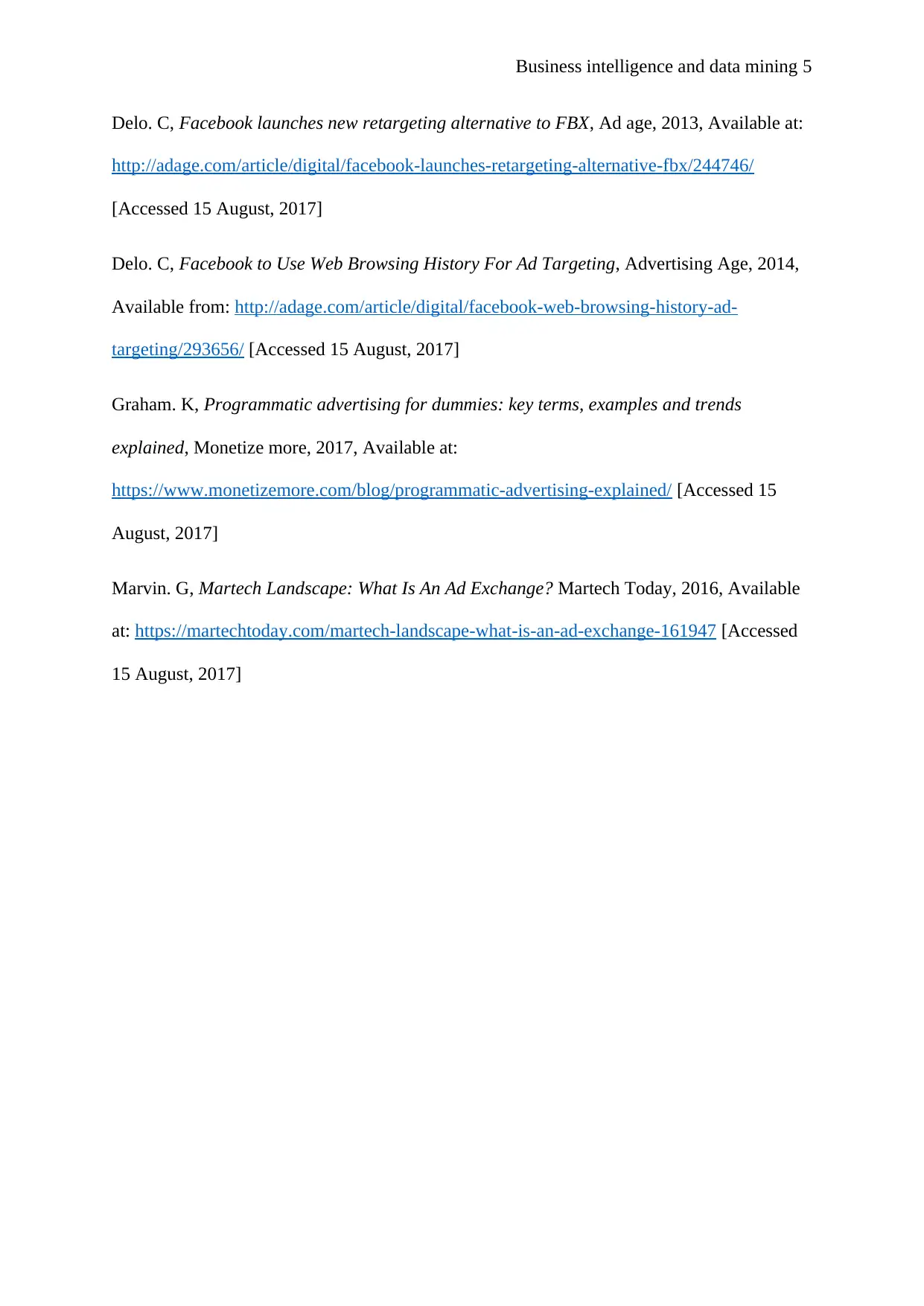Targeted Advertising in Social Media Sites: Analysis and Report
VerifiedAdded on 2020/03/04
|5
|1055
|41
Report
AI Summary
This report delves into the evolving landscape of targeted advertising within social media platforms. It examines the shift from traditional methods, such as 'Likes,' to more sophisticated approaches that leverage user data, browsing history, and preferences. The report highlights the role of ad exchange systems, where advertisers bid for space on social media platforms through programmatic advertising driven by Demand Side Platforms (DSPs). It explains how data, sourced from various online activities, is used to tailor ads, and how tracking software further refines targeting. The report concludes that advertisers can now directly reach customers based on IT systems, which provides them with the convenience to cut out the sales middlemen and make their marketing more efficient. Overall, this report provides a comprehensive overview of how businesses utilize data mining and business intelligence to enhance their targeted advertising campaigns, emphasizing the importance of user data and the technologies that facilitate these strategies.

Business intelligence and data mining 1
Targeted Advertising in Social Media Sites
Assignment
[Student Name Here]
[Institution’s Name Here]
[Professor’s Name Here]
[Date Here]
Targeted Advertising in Social Media Sites
Assignment
[Student Name Here]
[Institution’s Name Here]
[Professor’s Name Here]
[Date Here]
Paraphrase This Document
Need a fresh take? Get an instant paraphrase of this document with our AI Paraphraser

Business intelligence and data mining 2
Introduction
Social media websites have revolutionised advertising by introducing a new paradigm that
interacts with the consumers directly. In itself, social media allows businesses to reach
consumers based on their preferences and immediate needs. However, the most critical aspect
of this platform is the customer targeting programs that are usually done, where users are
provided with products based on their setting and browser history. This outcome is now a
common phenomenon notwithstanding the previous targeting methods that followed the
user’s ‘Likes’. In this context, the ‘Likes’ refers to the buttons used on social media sites such
as Facebook where a user will show his/her sentiments based on the given criteria. Now, in
the past, these buttons were hosted on various websites and when used would serve as a
preference setting while using the social media site1. Today, this process has gone a notch
higher to include retargeting methods that will use customer’s browser history and settings to
promote products and services on social media sites. This process is achieved using ad
exchange systems and affixing tracking Softwares as discussed below.
Ad exchange
This method of advertising follows the spaces provided by the multiple online publishers who
provide space inventory to advertisers based on an automatic bid system. This method
replaces the traditional method of negotiating for space based on a one-on-one interaction. In
essence, companies such as social media sites (e.g. Facebook) will avail space on their
platforms which other companies will automatically bid for based on programmatic
advertising method that is supplied by DSPs (Demand Side Platform)2. Now, programmatic
1 C. Delo, Facebook to Use Web Browsing History For Ad Targeting, Advertising Age, 2014,
Available from: http://adage.com/article/digital/facebook-web-browsing-history-ad-
targeting/293656/ [Accessed 15 August, 2017]
2 G. Marvin, Martech Landscape: What Is An Ad Exchange? Martech Today, 2016, Available
at: https://martechtoday.com/martech-landscape-what-is-an-ad-exchange-161947 [Accessed
15 August, 2017]
Introduction
Social media websites have revolutionised advertising by introducing a new paradigm that
interacts with the consumers directly. In itself, social media allows businesses to reach
consumers based on their preferences and immediate needs. However, the most critical aspect
of this platform is the customer targeting programs that are usually done, where users are
provided with products based on their setting and browser history. This outcome is now a
common phenomenon notwithstanding the previous targeting methods that followed the
user’s ‘Likes’. In this context, the ‘Likes’ refers to the buttons used on social media sites such
as Facebook where a user will show his/her sentiments based on the given criteria. Now, in
the past, these buttons were hosted on various websites and when used would serve as a
preference setting while using the social media site1. Today, this process has gone a notch
higher to include retargeting methods that will use customer’s browser history and settings to
promote products and services on social media sites. This process is achieved using ad
exchange systems and affixing tracking Softwares as discussed below.
Ad exchange
This method of advertising follows the spaces provided by the multiple online publishers who
provide space inventory to advertisers based on an automatic bid system. This method
replaces the traditional method of negotiating for space based on a one-on-one interaction. In
essence, companies such as social media sites (e.g. Facebook) will avail space on their
platforms which other companies will automatically bid for based on programmatic
advertising method that is supplied by DSPs (Demand Side Platform)2. Now, programmatic
1 C. Delo, Facebook to Use Web Browsing History For Ad Targeting, Advertising Age, 2014,
Available from: http://adage.com/article/digital/facebook-web-browsing-history-ad-
targeting/293656/ [Accessed 15 August, 2017]
2 G. Marvin, Martech Landscape: What Is An Ad Exchange? Martech Today, 2016, Available
at: https://martechtoday.com/martech-landscape-what-is-an-ad-exchange-161947 [Accessed
15 August, 2017]

Business intelligence and data mining 3
advertising is just a simple way of describing Software driven technologies that automate the
ad-buying processes.
Programmatic advertising: Two factors have led to the popularity of programmatic
functionalities; one, its automated activities that speed up the process of buying and selling
ads and two, the targeting relevance. The targeting relevance is usually accomplished using
large data (Big data and business intelligence) sourced from multiple platforms used by users.
Furthermore, this data will outline the user’s behaviour, demographic and preferences3. So,
where does the data come from? The data is harvested from websites and applications using
tools such as cookies as well as other identifiers such as User Login details. This information
is then used to tailor the ads.
Demand Side Platform: Advertisers e.g. Laptop selling companies, usually connect to ad
exchange using DSP who provide the link between the advertising space and the advertisers.
Examples of DSP include MediaMath, Turn and AppNexus among many others. Now, using
the ad exchange, advertisers will target their audience based on certain behaviours as
exhibited by their browsing activities. This outcome will enable a company to place an ad on
a social media site (e.g. Facebook) of a user, just after browsing it in a search engine4.
Affixing tracking software
Consider Facebook, a popular social media site that for a long time has used FBX as its ad
exchange. Now, because of this application, it has had to deal with DSP (e.g. Turn) to help
businesses target their audience. However, a better and more efficient method is slowly being
introduced into the market, that of affixing tracking Softwares into the marketer’s web sites
3 Refer to 2
4 K. Graham, Programmatic advertising for dummies: key terms, examples and trends
explained, Monetize more, 2017, Available at:
https://www.monetizemore.com/blog/programmatic-advertising-explained/ [Accessed 15
August, 2017]
advertising is just a simple way of describing Software driven technologies that automate the
ad-buying processes.
Programmatic advertising: Two factors have led to the popularity of programmatic
functionalities; one, its automated activities that speed up the process of buying and selling
ads and two, the targeting relevance. The targeting relevance is usually accomplished using
large data (Big data and business intelligence) sourced from multiple platforms used by users.
Furthermore, this data will outline the user’s behaviour, demographic and preferences3. So,
where does the data come from? The data is harvested from websites and applications using
tools such as cookies as well as other identifiers such as User Login details. This information
is then used to tailor the ads.
Demand Side Platform: Advertisers e.g. Laptop selling companies, usually connect to ad
exchange using DSP who provide the link between the advertising space and the advertisers.
Examples of DSP include MediaMath, Turn and AppNexus among many others. Now, using
the ad exchange, advertisers will target their audience based on certain behaviours as
exhibited by their browsing activities. This outcome will enable a company to place an ad on
a social media site (e.g. Facebook) of a user, just after browsing it in a search engine4.
Affixing tracking software
Consider Facebook, a popular social media site that for a long time has used FBX as its ad
exchange. Now, because of this application, it has had to deal with DSP (e.g. Turn) to help
businesses target their audience. However, a better and more efficient method is slowly being
introduced into the market, that of affixing tracking Softwares into the marketer’s web sites
3 Refer to 2
4 K. Graham, Programmatic advertising for dummies: key terms, examples and trends
explained, Monetize more, 2017, Available at:
https://www.monetizemore.com/blog/programmatic-advertising-explained/ [Accessed 15
August, 2017]
⊘ This is a preview!⊘
Do you want full access?
Subscribe today to unlock all pages.

Trusted by 1+ million students worldwide

Business intelligence and data mining 4
thus avail the same preferences to users when they connect to their social media platforms5.
This method will also guarantee the marketing process as the previous method (ad exchange)
relied on desktop feeds and ads placed on the right rails. In comparison, affixing Softwares
will automatically use the customer’s data such as email, location and contact number to avail
ads on their social media sites. Moreover, this method will make mobile inventory available
to marketers and users alike.
Conclusion
Advertising like any other aspect of business, has used the conveniences offered by the
digital medium to their advantage. Today, marketers can reach customers directly based on
the advertising systems presented by information technology, which cuts out the sales
middlemen who in the past sold advert space. Consider the first option, ad exchange, where
automatic algorithms source users’ data based on their preferences, demographic and
behaviour through their browsing activities. This information is relayed through DSPs who
connect advertising agencies and companies to ad platforms. Now, it is through such
processes that users experience the same content across different online platforms, for
instance, customers will see a products previously searched on their social media account.
Furthermore, this process is now intensified by the affixing tracking Softwares that aim to
directly harvest users’ information through their online presence. Therefore, an advertiser
will affix the programs in their website and through these applications will connect to the
user’s social media accounts thus provide the same content in them, an efficient and
controversial outcome.
References
5 C. Delo, Facebook launches new retargeting alternative to FBX, Ad age, 2013, Available
at: http://adage.com/article/digital/facebook-launches-retargeting-alternative-fbx/244746/
[Accessed 15 August, 2017]
thus avail the same preferences to users when they connect to their social media platforms5.
This method will also guarantee the marketing process as the previous method (ad exchange)
relied on desktop feeds and ads placed on the right rails. In comparison, affixing Softwares
will automatically use the customer’s data such as email, location and contact number to avail
ads on their social media sites. Moreover, this method will make mobile inventory available
to marketers and users alike.
Conclusion
Advertising like any other aspect of business, has used the conveniences offered by the
digital medium to their advantage. Today, marketers can reach customers directly based on
the advertising systems presented by information technology, which cuts out the sales
middlemen who in the past sold advert space. Consider the first option, ad exchange, where
automatic algorithms source users’ data based on their preferences, demographic and
behaviour through their browsing activities. This information is relayed through DSPs who
connect advertising agencies and companies to ad platforms. Now, it is through such
processes that users experience the same content across different online platforms, for
instance, customers will see a products previously searched on their social media account.
Furthermore, this process is now intensified by the affixing tracking Softwares that aim to
directly harvest users’ information through their online presence. Therefore, an advertiser
will affix the programs in their website and through these applications will connect to the
user’s social media accounts thus provide the same content in them, an efficient and
controversial outcome.
References
5 C. Delo, Facebook launches new retargeting alternative to FBX, Ad age, 2013, Available
at: http://adage.com/article/digital/facebook-launches-retargeting-alternative-fbx/244746/
[Accessed 15 August, 2017]
Paraphrase This Document
Need a fresh take? Get an instant paraphrase of this document with our AI Paraphraser

Business intelligence and data mining 5
Delo. C, Facebook launches new retargeting alternative to FBX, Ad age, 2013, Available at:
http://adage.com/article/digital/facebook-launches-retargeting-alternative-fbx/244746/
[Accessed 15 August, 2017]
Delo. C, Facebook to Use Web Browsing History For Ad Targeting, Advertising Age, 2014,
Available from: http://adage.com/article/digital/facebook-web-browsing-history-ad-
targeting/293656/ [Accessed 15 August, 2017]
Graham. K, Programmatic advertising for dummies: key terms, examples and trends
explained, Monetize more, 2017, Available at:
https://www.monetizemore.com/blog/programmatic-advertising-explained/ [Accessed 15
August, 2017]
Marvin. G, Martech Landscape: What Is An Ad Exchange? Martech Today, 2016, Available
at: https://martechtoday.com/martech-landscape-what-is-an-ad-exchange-161947 [Accessed
15 August, 2017]
Delo. C, Facebook launches new retargeting alternative to FBX, Ad age, 2013, Available at:
http://adage.com/article/digital/facebook-launches-retargeting-alternative-fbx/244746/
[Accessed 15 August, 2017]
Delo. C, Facebook to Use Web Browsing History For Ad Targeting, Advertising Age, 2014,
Available from: http://adage.com/article/digital/facebook-web-browsing-history-ad-
targeting/293656/ [Accessed 15 August, 2017]
Graham. K, Programmatic advertising for dummies: key terms, examples and trends
explained, Monetize more, 2017, Available at:
https://www.monetizemore.com/blog/programmatic-advertising-explained/ [Accessed 15
August, 2017]
Marvin. G, Martech Landscape: What Is An Ad Exchange? Martech Today, 2016, Available
at: https://martechtoday.com/martech-landscape-what-is-an-ad-exchange-161947 [Accessed
15 August, 2017]
1 out of 5
Related Documents
Your All-in-One AI-Powered Toolkit for Academic Success.
+13062052269
info@desklib.com
Available 24*7 on WhatsApp / Email
![[object Object]](/_next/static/media/star-bottom.7253800d.svg)
Unlock your academic potential
Copyright © 2020–2025 A2Z Services. All Rights Reserved. Developed and managed by ZUCOL.




